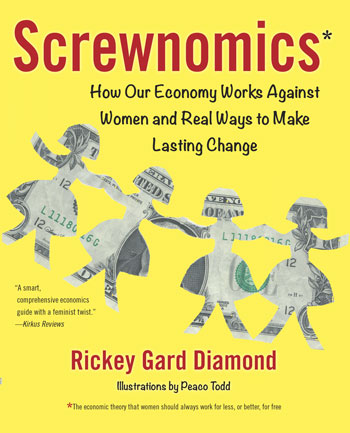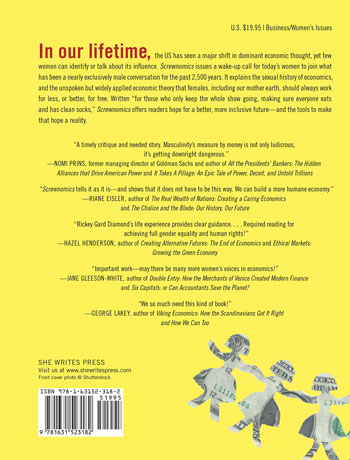|
|||||||
According to Diamond, through EconoMansplaining, EconoMan has made the economic game dry, boring and seemingly overly complicated, thus discouraging a more universal understanding of a realm that has such “concrete and far-reaching effects on our everyday lives.” Diamond meets EconoMansplaining head-on by interweaving her personal narrative with socioeconomic history, theory, and policy. Using thought-provoking cartoons illustrated by Todd, easy-to-understand economic definitions and creative (often food-related) metaphors, Screwnomics breathes life and brings meaning to the previously inaccessible realm of economic principles and policies. Finally, EconoMansplaining has met its feminine match. How many of us, for example, grasp the concept of stocks, a term we hear in the news on a daily basis? Thanks to Diamond, we learn that stocks “began in a time when few could read numbers, and so simple notched sticks kept track of counts. In England, these were called tally sticks. Splitting a notched stick in two provided a record of exchanges between two parties, carrying proof of a payment or debt. It was used in courts of law when disputes arose. Later refinements made tally sticks into two halves of different lengths. The longer one, given to the creditor that supplied goods or capital, was called the stock. The shorter one went to the one who owed payment, giving debtors ‘the short end of the stick,’ otherwise known as the foil.” This and many other important economic concepts, such as buying stock on margin, stock futures, long and short positions, and derivatives, to name but a few, are brought to life and down to earth in Screwnomics. More than just dismantling the past and present, however, Screwnomics also sets forth practical ideas for creating a socially progressive economic future. Ideas such as replacing the gross domestic product (GDP) with the genuine progress indicator (GPI). The GDP has long been used as an indicator of the economic growth and well-being of a state or country. It takes into account goods produced and services rendered, nothing more and nothing less. In 1968, Sen. Robert Kennedy explained that GDP “counts air pollution and cigarette advertising, and ambulances to clear our highways of carnage. It counts special locks for our doors and the jails for the people who break them. It counts the destruction of the redwood and the loss of our natural wonder in chaotic sprawl. It counts napalm and counts nuclear warheads and armored cars for the police to fight the riots in our cities. … Yet the gross national product does not allow for the health of our children, the quality of their education or the joy of their play. It does not include the beauty of our poetry or the strength of our marriages, the intelligence of our public debate or the integrity of our public officials. … [I]t measures everything in short, except that which makes life worthwhile.” Diamond proposes using the GPI, instead of the GDP, to capture an overall picture of economic growth and well-being and to shape economic policy. The GPI uses the GDP’s measures but also takes into account the social and environmental costs of those measures, many of which were articulated by Sen. Kennedy. Several states, including Vermont, have recently adopted the GPI. Other solutions Screwnomics proposes include investing more of our dollars on Main Street and fewer on Wall Street; creating a system of local banks; using local currencies and exchanges; establishing a time bank, wherein people trade services; and instituting a universal basic income as well as a 30-hour workweek. With the rise of the #MeToo movement, more women than ever are reclaiming their narrative and power over their bodies. In Screwnomics, women have a vehicle for reclaiming their narrative and power over their economic lives. Even more, we have a template for a long overdue female-centric, values-led economic revolution. Lori Lustberg is a freelance writer specializing in financial, legal, and tax issues.
|
|||||||
|
|||||||
Full disclosure: Rickey Gard Diamond, founding editor of the paper you are holding in your hand, is a friend of mine. Though in “objective” journalistic circles, my writing a review of her book could be construed as a no-no, my friendship does not prevent me from giving you, dear reader, my honest opinion of her collection of short stories, Whole Worlds Could Pass Away. As a former journalist, literature professor, and contributor to this paper (now freelance book collaborator), I promise you that I know good stuff when I see it. And while I cannot say every single piece of work in this collection is dazzling, I would say that, taken as a whole, it’s pretty damned freaking good. But it’s also extremely powerful medicine, best taken in short schlurps.
On the grim side, the opening story “The Bear” begins with a young girl’s memory of a bear rug, musty and toothed and occasionally animated (her boy cousins “chased her with it one time, wearing it like a cape”) that also feels sexy (“she loved to feel her belly against his back, stroking his fur … she felt a pleasure fierce as her fear”). The bear is both sex and death, and the deaths of the men in this Vietnam-era woman’s life throb through into the future black Vietnam Veterans Memorial Wall in Washington. There, the bear enfolds itself in her memory into a combination of deathliness and sexuality. The story is somber, symbolic, and weird, as several of the other stories are, but the common thread is sexual identity in all its forms. Rickey is an acute social observer who photographs beautifully through a gendered lens. She takes on male (repressed) and female (repressed then freed) views with equal acuity. Some of her passages remind me of the great short-story writer Tillie Olsen, whose story “I Stand Here Ironing” was one of the great ’70s-era shouts of feminine resentment. For example, in “Goldfish” Ann, a teenage girl, is crimped beneath her mother’s collusion with the ’50s status quo and that awful symbol of female repression, the ironing board: “Ann’s mother looks up from her ironing board … catching Ann’s tone, her eyes look empty of patience as she parks the steaming iron on end. In the moistness beneath the person Ann has become, she shrinks from her mother’s look that says: do you really think you know so much about me?” On the lighter side, there is a funny story of an ancient, independent, and crazy cat lady (“The Visitation”) who takes vengeance on her neighbors’ plucking off her 27 cats one by one by sneaking out into the night to dump herbicide on their tomatoes and, in the process, accidentally poisons their dog. Then there is the David Lynch–worthy “What Happened at Wanda’s Place,” a story Rickey told me she birthed after she noticed that the usually empty parking lot of a dive bar in the middle of religious-country-nowhere was inexplicably full of tractor-trailer trucks. Her imagination stimulated when she learned from the local news that the struggling bar was importing topless dancers to drum up business, Rickey envisioned the dancers: one tall, skinny, pretty, and reluctant; the other stout, short, enormously endowed, and very enthusiastic with a very subaverage IQ (“exuberant as a fat kid at a barbeque”; “if my dog had a face like that, I’d make it walk backwards!” says a male patron) who could do amazing things with her breasts. The POV is that of a male stranger who can’t believe his luck. The first time I read this story it creeped me out; the second time, it made me laugh out loud. I love these short stories as much as I like reading the ones in The New Yorker. Many are that good or better. I love Rickey’s midwestern, ironic, sometimes cynical and hard-bitten but always compassionate voice. But herein lies a warning: in this book the voice is concentrated, and reading these stories all at once is rather like swimming while holding your breath too long (water is a big symbol in this book). Like all good short-story collections, the experience is better taken in bits, so you can think about each story, take a breath and then dive back in for the next one. Taken together, the themes tend to overcrowd each other. Sometimes the symbolism is laid on a bit too thick (in “Goldfish,” the coming-of-age girls can sense somehow the swirl of the sexual origin of things, the black bear is the bearer of death, and so on), but the overall strength here is absolutely unavoidable.
|
|||||||
|
|||||||
Behind These Hills is in many ways a remarkable book and certainly not an easy one to read. In 1996 Susan Sanders suffered likely the greatest loss—the death of her child. Her 15-year-old daughter, Jessica Sicely, shot herself in the Vermont woods. After her daughter’s suicide, Sanders went through a 12-year process of writing and continuously revising poems about her daughter, struggling to come to terms with Sicely’s death. Several of the poems in this book have been published previously in literary journals, the first in 2006, among them Two Hawks Quarterly, Blue Moon Poetry, and Oracle Literary Journal.
Sanders begins with the shock of her daughter’s death in Behind These Hills, the book’s namesake poem: “Shock still silently swirls / in a bed of dead pine needles / holding what was once alive / holding the body you fought / so hard to be friends with.” In another poem (“Before”) in the first section of the book, Sanders imagines avoiding the inevitable, the line “The gun slides back in the drawer” beginning each of the poem’s four stanzas: “The gun slides back in the drawer / before my daughter walked / into the woods, a handgun / slung low on her thigh.” In the second group of poems by Sanders (the third section of the book), more time has passed since Sicely’s death, and though the speaker in the poems is hardly reconciled, some of the raw response if not exactly softened has acquired a certain wary weary distance. The poignant last stanza of the last poem in this section, Hades Nirvana, provides a segue to the last group of Sanders’ poems, which explore, in part, the Demeter-Persephone myth:
In the fifth section and the last group of Sander’s poems, the death of her daughter takes on, in some of the poems, a mythic or dream dimension, as the speaker sidles closer to partial closure. In “An Eclogue,” she addresses her daughter with a series of questions followed by imagined responses: “Why did you want to leave? / The woods called my name through the trees. / Did those angels carry you up above? / The last light slipped down to the ground.” And ends with a statement: “My heart hides inside a hollow shell. / There are winds which tell another story.” In the next to the last poem by Sanders, “Fault Lines,” the speaker comes as close as possible, perhaps, to some kind of reconciliation: “Then that invisible line / was no one’s fault. / It festered up slowly / inside her mind, / and was also no one’s fault / but the business / of what was not.”
In the poem that ends the book, Redemption, Sicely addresses God, the last two stanzas a fitting ending for this review:
Kate Mueller is a freelance book editor and editor of Vermont Woman newspaper. |
|||||||
|
Lori Lustberg is a freelance writer specializing in financial, legal, and tax issues. Kate Mueller is a freelance book editor and editor of Vermont Woman newspaper. Bronwyn Fryer is a freelance collaborative writer and book editor in Montpelier.
|
||||||





